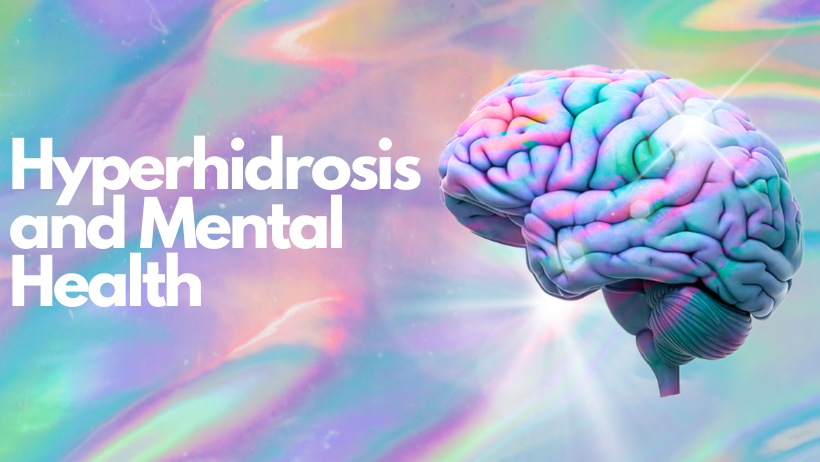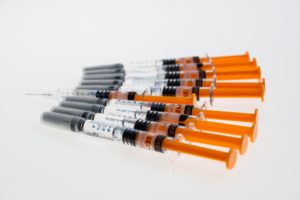What is Hyperhidrosis?
Hyperhidrosis is a medical condition marked by excessive and unpredictable sweating that is not necessarily linked to heat or physical activity. It goes beyond normal perspiration, causing significant disruptions in daily life, social discomfort, and embarrassment. This condition results in profuse sweating that can soak through clothes or lead to dripping hands. Unlike the typical response of sweating to regulate body temperature, hyperhidrosis involves an uncontrollable and disproportionate release of sweat. Treatment options for hyperhidrosis include antiperspirants, medications, and, in severe cases, surgical procedures aimed at mitigating the impact of the condition and improving the affected individual’s quality of life.
The diagnosis of hyperhidrosis involves considering specific criteria outlined by the International Hyperhidrosis Society. To be diagnosed with hyperhidrosis, individuals should exhibit visible and excessive sweating beyond what is considered normal, typically exceeding 100 milliliters per five minutes (see more on exact classification here). This sweating should occur at least once a week for a duration of at least six months, and it should be relatively symmetric on both sides of the body. Hyperhidrosis often begins in childhood or adolescence but can start at any age. Additionally, excessive sweating should significantly impair daily activities, such as work or social interactions. While these criteria provide general guidelines, a healthcare professional is essential for a comprehensive evaluation, including a thorough medical history, physical examination, and possibly additional tests to confirm the diagnosis and rule out any underlying medical conditions. When choosing a medical provider for diagnosis, it is best to find one that is hyperhidrosis-aware. To do so, you can check out the clinician finder from the International Hyperhidrosis Society.
Primary and Secondary Hyperhidrosis
Hyperhidrosis can be classified into two main types: primary and secondary.
Primary hyperhidrosis is characterized by excessive sweating that is not a symptom of any other medical condition or side effect and is not caused by external stimuli. It often occurs symmetrically on specific or focal body parts, such as the palms, sores, or underarms, and typically begins in childhood or adolescence. The exact cause of primary hyperhidrosis is not well understood, but it is believed to involve overactive sweat glands. Primary hyperhidrosis accounts for 93% of all cases.
On the other hand, Secondary hyperhidrosis is associated with an underlying medical condition or is a side effect of medications. It can affect larger areas of the body (focal or generalized) and often appears suddenly later in life. The medical conditions can range from endocrine disorders like Parkinson’s disease and stroke to infectious diseases such as tuberculosis and HIV/AIDS. Additionally, cardiovascular disorders like heart attacks and respiratory conditions such as asthma or chronic obstructive pulmonary disease (COPD) can contribute to profuse sweating. To add, rheumatologic disorders – certain cancers like lymphoma and leukemia, medications (such as antidepressants and chemotherapy drugs), and spinal cord injuries are also potential triggers for second hyperhidrosis. More rarely, but in some cases, the exact cause may be idiopathic.
Identifying and addressing the underlying cause of secondary hyperhidrosis is crucial for effective management. While primary hyperhidrosis is considered idiopathic and often requires targeted treatments to alleviate symptoms, secondary hyperhidrosis requires identifying the underlying cause of sweating.
Global Statistics on Hyperhidrosis
According to the International Hyperhidrosis Society, an estimated 385 million people globally suffer from hyperhidrosis. Notably, this prevalence surpasses other dermatologic conditions like psoriasis.
In the United States, research published in the Archives of Dermatological Research in 2016 revealed a prevalence rate of 4.8%, overall affecting around 15.3 million individuals. Interestingly, this estimate is nearly double the previously believed numbers, highlighting hyperhidrosis as more common than conditions such as autism and melanoma in the US. The study further revealed that hyperhidrosis is most common among younger populations, with 8.8% of individuals who suffer from the condition being aged 18 to 39, and the least common age category being children and adolescents (2.1%). To put this into perspective, the prevalence of hyperhidrosis exceeds the percentage of people with natural red or blonde hair in the US. It is also less common in elderly adults aged 65 or over, likely due to disease regression over time.
In Sweden, according to a Dermatology study from the same year, the figures on prevalence differ slightly. The reported prevalence of primary hyperhidrosis was marked as 5.5%, with severe cases affecting 1.4% of the population, while secondary hyperhidrosis was observed in a higher percentage, 14.8% of participants.
However, more general findings from PLoSOne in 2016 highlight regional variations that support the claim that primary hyperhidrosis is still more prevalent on the whole than secondary hyperhidrosis. This report states that the prevalence of primary hyperhidrosis among dermatology outpatients in Shanghai is 14.5% and 12.3% in Vancouver.
Despite the widespread occurrence of Hyperhidrosis, an estimated 27% of those affected never receive a formal diagnosis, therefore it is complex to pinpoint the true demographic or the sheer scale of the condition. As of today, there is no reported gender difference in hyperhidrosis, although one study found women are more likely to experience excessive sweating in axillae areas, whereas men, will likely be affected in craniofacial areas.
Aside from prevalence, global statistics also comment on the genetic link to the development of hyperhidrosis. Data from 2018 suggests that 18% of individuals report a family member also suffering from excessive sweating. These statistics underscore the commonality, impact, and often overlooked nature of hyperhidrosis as a chronic and multifaceted condition.
The Psychological Toll of Hyperhidrosis
Embracing Hope: Overcoming Hyperhidrosis with Resilience and Self-Acceptance
Hyperhidrosis, a condition characterized by excessive sweating, not only impacts individuals physically but also takes a toll on their mental and emotional well-being. The journey of living with hyperhidrosis often entails navigating through feelings of embarrassment, self-consciousness, and social anxiety. However, amidst these challenges, there is a glimmer of hope and resilience that shines through the darkness.
Research has highlighted the profound psychological impact of hyperhidrosis, with studies revealing higher levels of anxiety and depression among those affected. The relentless struggle to conceal sweating and the fear of judgment can lead to social withdrawal and profound feelings of isolation. Despite these daunting statistics, it’s essential to recognize that hyperhidrosis does not define individuals, nor does it diminish their worth.
One of the keys to overcoming the psychological toll of hyperhidrosis lies in embracing one’s uniqueness and reframing the narrative surrounding sweat. Society’s unrealistic expectations often lead individuals to feel flawed or inadequate, but it’s crucial to challenge these beliefs and celebrate the diversity of human bodies. Every individual, whether they have hyperhidrosis or not, deserves love, acceptance, and understanding. Especially from ourselves.
Furthermore, addressing the underlying factors contributing to excessive sweating is paramount. While physical interventions such as antiperspirants or medications can provide relief, mastering one’s mindset and emotional resilience is equally essential. By understanding the interplay between thoughts, feelings, and actions, individuals can regain control over their lives and cultivate a sense of empowerment.
In addition to individual efforts, fostering a supportive environment within society is crucial in reducing the stigma associated with hyperhidrosis. By promoting empathy and understanding, we can create a world where individuals feel safe to seek help and openly discuss their experiences without fear of judgment or ridicule.
Moreover, seeking professional support, whether through therapy or life coaching, can provide valuable tools and strategies for managing both the physical and emotional aspects of hyperhidrosis. Through cognitive-behavioural techniques, mindfulness practices, and self-coaching, individuals can develop coping mechanisms to navigate social situations with confidence and resilience.
Ultimately, the journey of overcoming hyperhidrosis is one of resilience, self-acceptance, and hope. By embracing our uniqueness, addressing the underlying factors, and mastering our mindset, we can rewrite the narrative surrounding sweat and reclaim control over our lives. Together, let’s embark on this journey with courage and optimism, knowing that a brighter, sweat-free future awaits us all.
Hyperhidrosis, beyond its physical manifestation, can have a significant psychological toll on individuals with the condition. The persistent and uncontrollable nature of excessive sweating can lead to profound feelings of embarrassment, self-consciousness, and social anxiety. Individuals with hyperhidrosis often find themselves navigating a daily struggle to conceal or manage their sweating, impacting their confidence and self-esteem. They can also deal with unorthodox challenges such as frequent clothing changes and multiple showers within the same day.
A 2016 research article in the Journal of the American Academy of Dermatology found that out of 2,000 individuals, approximately 21% to 27% of those who suffered from hyperhidrosis also showed higher levels of anxiety and depression. The findings also revealed that the more severe the sweating was, the more an individual was at risk for developing mental health issues. Other documented psychosocial factors associated with hyperhidrosis include sadness, anger and feelings of hopelessness.
At the more extreme end, individuals frequently communicate with the International Hyperhidrosis Society about sweat negatively impacting and dominating their lives. Their expressions have, at times, conveyed emotions of self-harm and suicidal thoughts; anxiety, isolation, depression, a pervasive sense of doom, shame, and a feeling of being an outcast. Additionally, they use the terms ‘panic,’ ‘disdain’, ‘disgust’ and ‘drowning’ to articulate the overwhelming impact of hyperhidrosis on their wellbeing.
The psychological impact of hyperhidrosis extends beyond the physical symptoms, highlighting the importance of addressing not only the visible aspects of the condition but also the emotional well-being of those affected.
Impact on self-esteem and body image
The nature of hyperhidrosis can have a profound influence on self-esteem and body image, significantly affecting the emotional well-being of individuals. The visibility of the condition may lead to feelings of insecurity, self-consciousness, and negative self-perception for those with hyperhidrosis, as well as pervasive fears of judgment and rejection.
The combination of these can influence an individual’s decision to avoid social scenarios and activities that could potentially expose their sweating. Or if they do partake in activities, they may develop an ongoing effort to conceal or manage the condition over time. However, this relentless focus on sweating management may create a distorted body image, with it not only affecting the individual’s self-esteem but may create a sense of being defined by the condition rather than identifying as one’s true self.
This may, in turn, hinder the formation of social connections and intimate relationships.
Social and emotional toll implications
The social and emotional toll of hyperhidrosis is marked by profound implications.
Statistics indicate that individuals with hyperhidrosis often deal with heightened levels of social anxiety, with the fear of judgment often leading to social withdrawal. The mere fact that a staggering 85% of those affected wait over three years before seeking medical attention for excessive sweating, underscores the prolonged emotional distress and stigma endured silently. This societal stigma attached to hyperhidrosis can not only aggravate the diagnosis process but can impact an individual on a more personal level- affecting the ability to form and maintain meaningful relationships.
These implications can also stretch to more public and professional settings, such as the workplace. Studies have revealed that individuals managing hyperhidrosis report increased stress levels and workplace difficulties. This burden, coupled with the constant effort to conceal sweating, contributes to an increased risk of mental health issues, with symptoms of depression being a prevalent concern. The link between hyperhidrosis and its adverse effects on mental well-being emphasizes the urgency of fostering understanding and empathy within society, promoting timely interventions, and creating supportive environments that acknowledge and address the emotional impact of this condition.
Does anxiety cause excessive sweating?
Sweating due to anxiety is a common and natural response tied to the body’s natural fight-flight mechanism. When confronted with a stress or perceived threat, the sympathetic nervous system is activated, releasing stress hormones like adrenaline and prompting the activation of sweat glands.
When it comes to excessive sweating, it seems like the relationship between hyperhidrosis and anxiety is cyclical. Anxiety has the potential to induce sweating, but the awareness of excessive sweating can also contribute to heightened anxiety.
Certain types of anxiety exacerbate sweating more, such as social anxiety disorder. Living with social anxiety entails navigating intense stress and fear surrounding the potential for embarrassment or negative judgment from others. These feelings can heighten in situations such as joining a group, public speaking or meeting new people. Despite efforts to avoid drawing attention, concerns about being judged for sweating excessively persist. The interplay between fear, stress and sweat becomes apparent through physical symptoms like warmth, flushing (especially around the face), head pain, light-headedness, trembling, clamminess in the hands, nausea, and shortness of breath. Notably, the fear of sweating can mirror emotional distress resembling social anxiety symptoms. Individuals aware of their excessive sweating may harbour nervousness about being noticed, leading to a potential cycle of avoidance in social situations. Consequently, this fear may prompt the avoidance of social events where sweating might become conspicuous.
Research Statistics and Facts
According to Healthline, up to 32% of individuals with social anxiety experience hyperhidrosis. An initial study found that in 2002, co-morbidity between the condition and social anxiety disorder was experienced by over 25% of individuals surveyed. Later in 2016, another report compared the rates of anxiety and depression in people with hyperhidrosis to controls (those without). 21.3% of those with hyperhidrosis had anxiety, and 27.2% had depression. In contrast, for people without hyperhidrosis, only 7.5% displayed anxiety and 9.7% were classified as having depression. To concur with these results, a separate 2014 report also showed that in severe cases of hyperhidrosis, nearly half of the patients (47.1%) had social anxiety disorder, while only 13.8% of those without hyperhidrosis had this condition. These findings highlight a strong connection between hyperhidrosis and social anxiety, suggesting that the two often occur together.
In addition, findings from a 2021 Systematic Review suggest other anxiety disorders are also linked with increased sweating, such as panic disorder and specific phobia. When reviewing 86 studies, researchers found that on the whole, increased sweating was a markable symptom for those with panic disorder, irrespective of confronting stress-inducing scenarios. In contrast, individuals with phobias demonstrated an elevated level of sweating more specifically when confronted with the object of their phobia.
How to prevent anxiety sweating?
Engaging with a therapist to address symptoms of anxiety or any other mental health condition can be impactful. While managing the root cause, which in this case, may be sweating-induced anxiety – seeking professional help can significantly impact negative thought patterns and challenge irrational cognitive behaviours. Seeking ongoing support from a therapist is advisable for persistent emotional or mental health symptoms, regardless of their direct origin.
A therapist can play a crucial role in preventing anxiety-induced sweating by employing effective cognitive techniques, particularly within the framework of cognitive-behavioral therapy (CBT). Through cognitive restructuring, therapy can assist individuals in identifying and challenging negative thought patterns associated with sweating-induced anxiety, fostering more balanced perspectives.
Additionally, mindfulness and relaxation techniques are introduced to promote stress management and detachment from distressing thoughts and sensations.
Alternative treatments such as exposure therapy or stress management strategies can also allow individuals to develop coping mechanisms. Overall, therapists aim to empower individuals with the cognitive tools necessary to navigate social situations confidently and reduce the emotional impact of anxiety-induced sweating.
On the other hand, individuals can seek treatment to ease the physical manifestations of hyperhidrosis. Various options are available, such as antiperspirants with higher concentrations of aluminum salts (10-20%). This can be prescribed by a doctor or clinician when over-the-counter alternatives prove insufficient.
Another effective treatment is Iontophoresis – a process involving weak electrical currents applied to hands, feet and underarms submerged in water for up to 40 minutes. This procedure aims to block the sweat glands; however, it is worth noting that these sessions provide temporary effects, therefore several sessions may be required.
Anticholinergic medications, whether applied topically or taken orally, function by inhibiting specific cellular signals, particularly those responsible for triggering sweat gland activity. In addressing excessive sweating, healthcare professionals may recommend off-label use of oral oxybutynin or topical glycopyrrolate as part of the treatment plan.
Injections of Botulinum toxin (Botox) function similarly to anticholinergics by impeding the release of the neurotransmitter acetylcholine, a catalyst for sweat production. The treatment entails multiple injections, yet the effects of Botox can persist for up to two years.
Conclusion
In conclusion, acknowledging that hyperhidrosis is a common condition – affecting an estimated 385 million people globally, is crucial for fostering awareness and understanding. Beyond its physiological impact, hyperhidrosis can significantly affect the mental health of individuals, such as being connected to higher levels of anxiety and depression. Recognizing this link is essential for early intervention and comprehensive care. The social and emotional toll of hyperhidrosis underscores the importance of creating supportive environments and reducing the societal stigma associated with this condition. By embracing a holistic perspective that encompasses both the visible and emotional aspects of hyperhidrosis, we can promote empathy, encourage timely interventions, and improve the overall quality of life for individuals navigating this challenging medical condition.
References
- International Sweat Help Society – https://www.sweathelp.org/
- Diagnosis and qualitative identification of hyperhidrosis – https://shc.amegroups.org/article/view/5191/html
- COPD – https://www.nhs.uk/conditions/chronic-obstructive-pulmonary-disease-copd/
- Hyperhidrosis: an update on the prevalence and severity in the United States https://link.springer.com/article/10.1007/s00403-016-1697-9
- PLoSOne (2016) Study – https://www.ncbi.nlm.nih.gov/pmc/articles/PMC4841532/
- Incidence and prevalence of hyperhidrosis https://pubmed.ncbi.nlm.nih.gov/25152338/
- Understanding Patient Experience With Hyperhidrosis: A National Survey of 1,985 Patients https://pubmed.ncbi.nlm.nih.gov/29601615/
- Excessive Sweating Linked To Anxiety And Depression News24 Article https://www.news24.com/life/wellness/body/condition-centres/depression/news/excessive-sweating-linked-to-anxiety-and-depression-20161208
- Social Anxiety Disorder – More Than Just Shyness https://www.nimh.nih.gov/health/publications/social-anxiety-disorder-more-than-just-shyness#:~:text=Social%20anxiety%20disorder%20is%20an,social%20anxiety%20disorder%20is%20treatable.
- Anxiety And Sweat – Healthline https://www.healthline.com/health/diagnosing-hyperhidrosis/depression-and-anxiety
- Hyperhidrosis in social anxiety disorder https://pubmed.ncbi.nlm.nih.gov/12502021/
- The prevalence of anxiety and depression in patients with or without hyperhidrosis https://pubmed.ncbi.nlm.nih.gov/27567033/
- The psychiatric facet of hyperhidrosis: demographics, disability, quality of life, and associated psychopathology https://pubmed.ncbi.nlm.nih.gov/25036589/
- Panic Disorder https://www.nhsinform.scot/illnesses-and-conditions/mental-health/panic-disorder/#:~:text=Panic%20disorder%20is%20where%20you,to%20stressful%20or%20dangerous%20situations.
- Specific Phobia https://www.nimh.nih.gov/health/statistics/specific-phobia#:~:text=Specific%20phobia%20is%20an%20intense,brings%20on%20severe%20anxiety%20symptoms.





